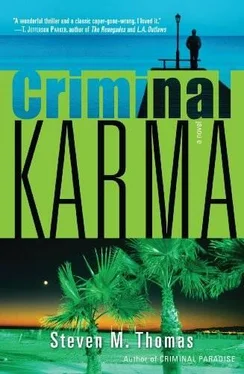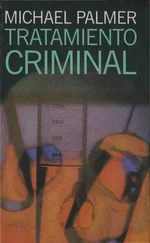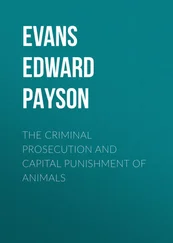At the first side road, I pulled over and ditched the stolen plates and put mine back on, then pointed the dark-blue nose of the car back toward the light-blue sky. Centrifugal force shifted us back and forth like slow windshield wipers as I navigated the sequence of hairpin curves that led to the top of the mountain, our torsos leaning one way and then the other. Indian Wells dropped away behind us, resorts, roads, and golf courses shrinking and flattening until the valley floor looked like the etched surface of a computer chip. Up among the pines, near the log-cabin Christmas village of Idyllwild, we ran into a snowstorm.
“Where’d this come from?” Reggie said.
“It’s the elevation, man. Indian Wells isn’t much above sea level. We’re at seven thousand feet here.” The dreamlike blend of environments-a wintry world in such close proximity to the palmy world of the desert-was one of the things I loved about Southern California.
“That’s wild,” Reggie said, an uncharacteristic note of wonder in his voice.
I looked over. “You want to stop and make a snowman?”
“Fuck you,” he said. “What’s your next great plan, anyway, since this was a bust? You got anything lined up, or are we shit out of luck?”
“I’m going to get that necklace.”
“Oh, fuck,” he said. “Here we go.”
We took Highway 74 all the way to Orange County, over the top of the San Jacintos, down into and across the wide Moreno Valley, with its endless pastures and vast herds of dairy cattle, then up and over the southern part of the Santa Ana Mountains to hit I-5 at San Juan Capistrano. Ninety minutes later, at 1 p.m. on Saturday, we exited the interstate at Venice Boulevard and cruised seaward between the double row of royal palm trees that lined the avenue.
I parked in a gravel lot with a chain around it where I rented a space by the week. The skinny old black man who ran the lot nodded as we walked past his hut.
“Genamuns.”
“How are you, Mr. Parker?” I said. He had an ironic name, too. He thought it was funnier than most of the people to whom he mentioned it repeatedly.
“ Superior,” he said. “It’s a bee -you-tee-full day at the beach.”
Which it was. Seventy-eight degrees with 45 percent humidity according to the static-filled weather update playing on his portable radio. The tangy breeze blowing in from the bay was soft as a cotton ball on the skin. Above us, the sun poured out an endless stream of radiance that bathed the toy buildings and tiny palm trees along the coast with cheerful photons. The snowy mountains had receded into dreamland.
The lot was at the corner of Horizon and Main, halfway between the Santa Monica and Venice piers, two blocks from the flophouse where we’d been staying for the past six weeks since leaving the Georgian Hotel. Walking to the house, I glimpsed a dark-blue slice of the Pacific sparking between two brick buildings and felt a glimmer of the excitement I always felt when I came to the edge of the continent.
The flophouse was one of two big frame structures sandwiched in between commercial buildings on the ocean side of Pacific Avenue, the main north-south drag in Venice Beach. They were worn-out Victorians built in the teens or twenties as private residences, later converted to boardinghouses.
Pacific Avenue ran parallel to the beach, a block inland from the boardwalk. It was a deep block, a world unto itself. The side streets that connected Pacific to the boardwalk had names like Zephyr, Wave Crest, and Sunset. They were packed with bars, tattoo parlors, hamburger stands, and souvenir shops selling seashells and funny T-shirts.
Venice was founded early in the twentieth century by a tobacco millionaire from back east named Abbot Kinney, who modeled it on the famous Italian city, with miles of canals cut into the salt marshes, and marketed it successfully as a beach vacation destination, the Coney Island of the West, with a 1,200-foot amusement pier and seafront hotels. Kinney was a brilliant entrepreneur, and the resort thrived during his lifetime but fell on hard times after he died in the 1920s. A fire destroyed the first pier, and most of the romantic canals were filled in and converted to streets during the 1930s and ‘40s. Beatniks descended in the 1950s, followed by hippies a decade later, both groups attracted by the cheap rents and quaint atmosphere. The city hit its nadir in the 1980s, when rival gangs took over poor neighborhoods, gunning one another down along streets lined with shabby bungalows.
Now Venice was on an upswing again. There was a Democrat in the White House and a bull market on Wall Street. Property values were rising as prosperity returned to Los Angeles in the wake of the post-Cold War recession. Gentrification was creeping down the beach from Santa Monica, old apartment buildings and arcades bulldozed to make way for luxury condos and cute boutiques.
The flophouse would disappear beneath the tide of redevelopment in the near future. In the meantime, we shared it with a triad of down-and-outers who occupied the first floor while we rented two furnished rooms and a bathroom at the top of a creaky wooden staircase. Two other big bedrooms on the second floor were unoccupied.
Going through the front door into the living room, we found Pete lying on a broken-down couch, reading a library copy of How to Win Friends and Influence People, a good book that gave birth to an annoying industry of high-pressure happiness salesmen. There were empty wine bottles, beer cans, and fast-food containers scattered around the room, remnants of the usual Friday-night party that comprised card playing, drunk chicks, and arguments with the landlady.
“Back from the desert already?” he said, sitting up with his habitual abruptness and placing the book, front cover down, on the wooden packing crate that served as an end table. “Why you guys dressed like that?”
“Like what?” Reggie said, looking down at his vaudeville pants and sandals. I didn’t say anything. I didn’t recall telling Pete that we were going to the desert.
“Where’s the other two stooges?” Reggie said.
Pete’s face tightened. He didn’t like Reggie’s habit of referring to him and his roommates as the Three Stooges. Reggie knew it, which was why he kept doing it. It was part of his personality to always be stirring up a little trouble, whether there was a use for it or not.
“They’re jacking off,” Pete said.
Reggie made saucer eyes. “Together?”
“Negative. I don’t allow any grab-ass in the house.”
Pete was the Moe of the group. When they worked, which wasn’t all that often, he was the one that organized the jobs, laboring at construction sites up the road or doing yard work in the canal district, a few blocks south, where expensive homes lined the few waterways that hadn’t been filled in. He was five feet seven inches tall, about 150 pounds, with short brown hair and a neatly trimmed Fu Manchu mustache.
“How do you know they’re jacking off?” I said.
“I saw Candyman heading for his berth with a stack of Hustlers.”
“How about Budge?”
“That particular individual is always jacking off,” Pete said. “Why you back so soon?”
He was full of questions.
“We got homesick,” Reggie said.
Upstairs, I put the pink diamond earrings and the.32 in my stash, took a shower, and changed into Levis, black Reeboks, and a midnight-blue T-shirt, the same color as my Seville. Our rooms were in the back of the house. The oversize double-hung window in my bedroom had admitted unobstructed sea breezes at one time. Now it held a view of the metal fire escape on the back of a run-down apartment building ten feet away, across an alley.
Читать дальше












